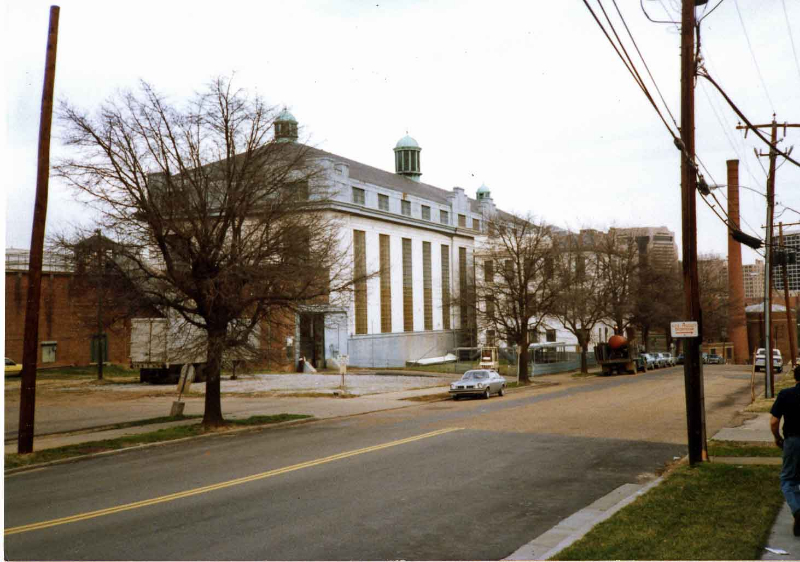On Friday, 24 February, a new historical highway marker will be unveiled at the site of the former Virginia Penitentiary at the intersection of Belvidere and Spring Streets in Richmond. The marker, sponsored by Richmond author Dale Brumfield, was approved by the Virginia Department of Historic Resources on 30 June 2016. The Penitentiary closed on 14 December 1990. The Ethyl Corporation, which purchased the 16-acre property for $5 million in December 1987, demolished the Penitentiary in
1991-1992 to build their corporate headquarters on the site. The records of the Virginia Penitentiary at the Library of Virginia document the closing and demolition of the buildings.
After the state sold the site to Ethyl, the plan was to close the Penitentiary on 1 July 1990. By that time, two new correctional facilities being built in Buchanan and Greensville counties would be finished and operational. Construction delays pushed back the openings of these new prisons and the closing of the Penitentiary was rescheduled for December 1990. In April 1990, A Building, the oldest prison building built in 1904, was closed and the prisoners relocated to B Building. A Building was in terrible condition: rusted cells, peeling paint, and pigeon droppings on the floor. B Building, built in 1939 and opened in 1942, wasn’t much better. A July 1990 inspection by the American Civil Liberties Union (ACLU) National Prison Project, as reported by the Richmond Times-Dispatch, described some of the conditions:
- “Prisoners are double-bunked in cells so small that the man on the top bunk cannot sit upright.
- The entire unit is filthy and roach-infested and prisoners are given no supplies to clean their cells.
- Most prisoners are confined to their cells 22 ½ hours a day…
- Heat is unbearable in the five-tiered cell blocks.
- Plumbing is antiquated and inadequate; standing water is everywhere and toilets frequently are stopped up and do not work.”
With the openings of the Greensville Correctional Center and Keen Mountain Correctional Center in September 1990, the Department of Corrections began transferring prisoners from the Penitentiary to the new facilities. By December there were only four prisoners left in B Building – Bobbie Rogers, Paul Stotts, Albert Vanderstuyf, and Dean Ratliff. On Friday 14 December 1990 the Virginia Penitentiary closed. Warden Raymond Muncy spoke a few wards at the closing ceremonies. “This old edifice has served the commonwealth well,” Muncy said according to the Richmond Times-Dispatch. “It has stood for a symbol of law and order and for the protection of the citizens. Today, we will place it into history.” Muncy ordered a last count of inmates. “Mr. Muncy,” Major Early T. Turner replied, “the count at the Virginia State Penitentiary is now zero.” Muncy declared the Penitentiary closed, and the state and U.S. flags were lowered.
Though now closed, the Penitentiary site was not immediately turned over to Ethyl. The Department of Corrections retained use of the facility until April 1991. Why? In case they needed to use the state’s electric chair. A new death chamber was under construction at Greensville but wasn’t scheduled to open until spring 1991. Housed in the basement of A Building, the state electric chair, by law, must be maintained and ready for use. It couldn’t be moved in the interim because only the Penitentiary had the electrical set up to use it. Joseph M. Giarrantano, Jr. was scheduled to be executed on 22 February 1991 and brought to the Penitentiary. The execution did not take place. Virginia Governor Doug Wilder commuted Giarrantano’s death sentence to life in prison on 19 February 1991. The electric chair was moved to the Greensville Correctional Center on 26 February 1991. Raymond Muncy left the Penitentiary for the final time on 1 March 1991. Demolition of the site began in August 1991 and was finished a year later.
The unveiling and dedication of the Virginia Penitentiary historical marker is scheduled for 24 February at 3PM at the intersection of Belvidere and Spring Streets in Richmond. Guest speaker for the dedication will be Evans D. Hopkins, author of the 2014 memoir Life after Life: A Story of Rage and Redemption.
-Roger Christman, Senior State Records Archivist























